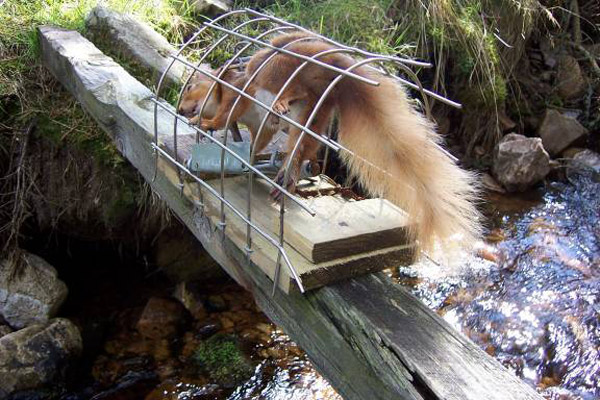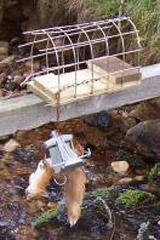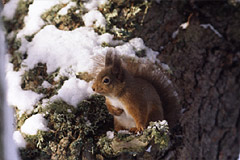|
|
|
|
|||
| Views on Conservation issues for Squirrels 4th August 2005 |
|||||
Letters discuss threats facing red squirrels
Red squirrels at risk: Red squirrels discovered killed this year in traps found within the Cairngorms National Park. BSCG suspect the intended victims were pine martens.
Sir, - I was somewhat interested to read in Bert Burnett's letter ("Strathy" July 27), representing the Scottish Gamekeepers Association, that he states "gamekeepers are extremely concerned about the threat posed to the red squirrel by pine marten and woodland hawks". While I am, of course, pleased to see that red squirrels are so high up on the gamekeepers' list of concerns, I feel there are a couple of points that ought to be made clear regarding threats posed to the red squirrel, as it concerns me that readers may be erroneously led to believe that indeed pine martens and birds of prey are linked to the serious overall decline of the red squirrel in Britain. Firstly, the diet of pine martens is very varied and consists mainly of field voles, and only in poor vole years do they increase the very low percentage of red squirrels that they normally take. The sparrowhawk, our commonest woodland hawk, takes mainly birds, with squirrels constituting only up to 0.04% of prey as shown by a major study in Scotland. This same study also noted that red squirrels were occasionally seen feeding on sparrowhawk eggs! While all these predators will indeed occasionally take red squirrels, generally they constitute a very low percentage of their diets, and, as studies have shown, only in areas where the numbers of red squirrels are already low, and other prey is scarce, may there be any threat from predation to their continued existence. So ensuring that there are healthy and numerous red squirrel populations and good habitat are far more beneficial to them than talking about controlling predators. I would also like to point out that the pine marten is itself a UK Priority Species and subject to much conservation effort to increase their distribution and to have a gamekeeper indicating the thought that they are a problem species is a worrying one. In September, 2000, a consultation paper on pine marten re-introductions in England was undertaken, and of the 171 gamekeepers within woodland areas of six English counties consulted on this issue, 65% responded in favour of reintroductions. While the National Gamekeepers' Association (NGA) counteracted with their own consultation, which interestingly itself showed that one-third of 803 gamekeepers were similarly in favour, it was clear from the NGA's conclusions that the main concern was fear about predation of gamebirds for their general opposition to the re-introduction of pine martens to England. As recognised by all authoritative groups working on red squirrel conservation in the UK the main threats to their survival are: competition from the introduced grey squirrel; habitat loss and fragmentation; and disease from the parapox virus carried by the grey squirrel. These are the areas that really need our attention. It is misleading to attempt to divert the argument in favour of controlling birds of prey and pine martens that in reality are disliked by gamekeepers due to their predation of gamebirds. Should the grey squirrel invade the reds' Highland stronghold then we may just be thankful for the presence of such predators in the woodlands, as they may well prefer the larger and more ground-dwelling American grey squirrel for dinner. We should not focus on reducing the numbers of what may well turn out to be some of the red squirrel's greatest allies. What we all need to do is be vigilant for the presence of any grey squirrels in the Highlands and report any sightings, and also to protect, increase and connect up the woodlands and forests, and it is by these means that we can truly show our "extreme concern" for our evocative native red squirrel. - Yours etc, TIM RANSOM Flat 8, 1 St Saviours Crescent, St Saviour, Jersey, Channel Islands. Sir, - Bert Burnett of the Scottish Gamekeeper's Association writes of heron and red squirrel in this column (July 27) "neither species is a threat to wildlife (or gamebirds)". On the other hand, and without providing detail (which also seems to be lacking on the website of the association), he mentions the extreme concern of gamekeepers "about the threat posed to the red squirrel by the pine marten and woodland hawks". Assuming that his concern over squirrel predators is indeed based on the interests of red squirrel conservation can I outline a few reasons why it seems inappropriate, especially given other recognised threats faced by our native red squirrel? Along with habitat fragmentation, inappropriate woodland management and disease, another great concern for the future of our red squirrel population (as noted for example in the Cairngorms Local Biodiversity Action Plan) is the spread of the grey squirrel. Numerous reliable reports indicate that the spread of grey squirrels into areas occupied by reds is often followed by loss of the red squirrels. Given appropriate woodland habitat and no introduced grey squirrels however, predators and red squirrels have co-existed without serious problems for red squirrels, even in gamekeeperfree locations with a wider array of native predator species than in Scotland. It is worrying that greys appear resistant to some diseases that are lethal to red squirrels and could transmit these when they come into contact with populations of reds. One such contagious disease considered in normal circumstances to be lethal to our native red squirrels is parapox. Given the very significant vulnerability of red squirrels to disease, any selection by predators of unhealthy individuals could have an especially valuable function in reducing the risks of disease spreading in the population. Circumstantial evidence indicates that grey squirrels should have more to fear from predators like pine martens than reds. Greys are heavier, and studies have shown that typically they spend more time foraging on the ground, where tree squirrels are most exposed to predators. In judging whether natural predators at natural levels are beneficial or detrimental to securing a future for our native red squirrel, it is perhaps worth reflecting that predators of reds are likely to find greys easier targets. Squirrel predators are also likely to selectively take precisely the individuals crossing unfavourable open habitat whose arrival in our pinewoods could so easily lead to the final demise of the red squirrel in Britain. - Yours etc, GUS JONES Fiodhag, Nethy Bridge. Habitat You highlight the plight of the red squirrel (8 June), but fail to mention one of the biggest threats to its survival in the Highlands - greedy developers, aided by the Scottish Executive, which is over-ruling local planning committees and allowing their habitat to be destroyed. A case in point is the decision to allow developers to build more than 100 houses in woodland at Carrbridge, where red squirrels are a common sight. Patricia Masterson CARRBRIDGE, INVERNESS-SHIRE
|
|||||




